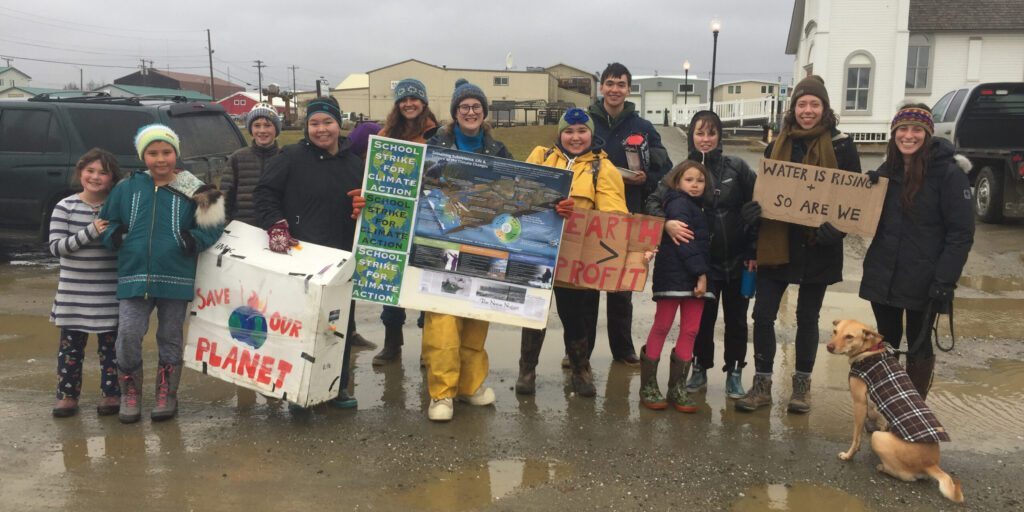Approximately 4500 climate change strikes have happened around the world as part of the Global Week for the Future, and one of them took place in Nome. Inspired by the action they’ve seen worldwide, last week nine Nome-Beltz students gathered to raise awareness for climate change, with special attention to sea ice and its impact on subsistence.
KNOM’s Joe Coleman reports:
Chanting and carrying “no planet B” signs, students stood firm in their decision to strike. Two of the student-organizers spoke about why they were skipping a day of school to stand on a street corner, even in the pouring rain.
“We’re hoping to accomplish more climate awareness, and we want adults – because we’re not old enough to vote yet – to elect leaders that care about climate change.”
That’s Zoe Okleasik, a junior at Nome-Beltz. The other student-organizer, Lizzy Hahn, a sophomore, says she took inspiration from another teenager, Greta Thunberg, a sixteen-year-old who spoke at the United Nations Climate Change Summit, starting these climates strikes. Here is a press release from Hahn, announcing the local high schoolers’ climate strike:
“My name is Lizzy Hahn. I am a 10th grader at Nome Beltz High School in Nome Alaska. I organized a climate strike school strike along with Aralye Lie. The reason why we wanted to strike is because of the need to put a spot light on climate emergency. It is no longer just climate change, its now an emergency.
What caught our attention was when 16 year old, Greta Thunberg took time off from school to demonstrate outside of the Swedish Parliament demanding climate action. She sailed to America with a solar powered boat to meet UN leaders and tell them what she wished for our world. She didn’t have to come by a boat run on solar energy, but she chose what she thought was right. She thought protesting against climate change and its cause, the use of fossil fuels, would be a great start. All of the things she says helps teenagers and adults understand what our future is going to be like. Kids up here in Alaska are experiencing it the most severe effects of climate change. We are right on the forefront of climate change. We experience it year around. We here in Nome, experience first hand the devastating effects of the decrease in sea ice. What are we going to do if we no longer have the subsistence food to live off on? How can you help make the world a better place? Greta Thunberg has inspired the whole world to go on strike. That is what we are doing. This letter you are reading states that two Alaskan girls are recognizing the changes in our world. Changes that are happening right now, that world leaders are ignoring. Sure, we may not get any recognition, but at least we are believing that things can change. So Friday, September 27th, us here in Nome are going to take a stand. If we don’t get the answer we deserve then we’ll organize even more protests until we get heard. We must take steps to reduce CO2 emissions by at least 50% by the year 2030. We are going on strike to demand action. It’s our future and we will not let it go to waste. We must take steps to protect this earth.”

Hahn gave examples of how climate change is impacting Nome residents like herself and harkened back to the numerous snow storms of last winter. Hahn and her family live outside of Nome city limits, which she says made the harsh winter challenging.
“I was stuck at home last winter for ten days. Like ten – I missed ten school days – because I could not get to school. I could – I…was stuck – I was stuck at home, like, there was no way to school. So, after that winter I was like ‘okay, we need to do something – or, I need to do something…”
One specific element of Nome’s climate strike compared to other ones around the state, country, and world was addressed by Okleasik. She says their focus on subsistence is fairly unique to Western Alaska.
“I’m really passionate about it because my family in particular – or not my family but my friends family – they need the sea ice for subsistence, and subsistence is such a big deal here because the stores prices are so expensive and in the winter when the planes can’t fly in there’s nothing in there.”
Both Nome-Beltz high schoolers called on other youth to take action and join them in advocating for change.
“If you’re a student and you’re listening to this and you’ve been thinking about planning a strike […] talk to someone – like a teacher – who would support you, and talk to an adult who would support you – someone in the community – and try to plan a strike in your own town or city or village, because this is very important…”
– Lizzy Hahn
“And I also wanted to say that we as youth should realize that we have a voice and adults will listen to us […] so use your voice and use it for the right reasons.”
– Zoe Okleasik
With more than four million people striking world-wide, these young Nome-ites, living in a region directly impacted by climate change, are looking to make their voices heard too.
Image at top: Photo by Diana Haecker of Nome Nugget, used with permission (2019).




